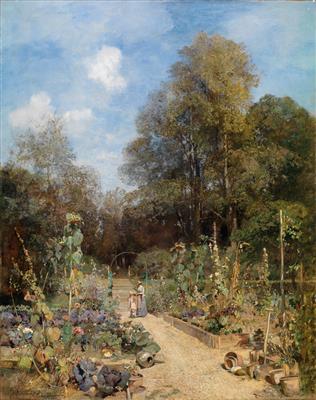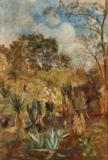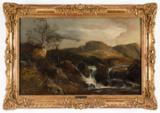Emil Jakob Schindler

(Vienna 1842–1892 Westerland auf Sylt)
Garden in Plankenberg, signed, dated, titled 1886 Schindler Plankenburg, oil on canvas, 83.5 x 66.5 cm, framed, (Rei)
Provenance:
Christian Herrmann (1837-1915);
His daughter Grete Zechmeister, Salzburg;
German private collection since the 1960s
Catalogued and illustrated in:
Heinrich Fuchs, Emil Jakob Schindler, Zeugnisse eines ungewöhnlichen Künstlerlebens, catalogue raisonné Vienna 1970, p. 240, no. 527, ill. 71.
We are grateful to Dr. Alexander Klee for his assistance in cataloguing this work.
Schindler’s Garden in Plankenberg can be regarded along the same lines as the paintings of cottage gardens that appeared in his work starting around 1878. In this painting, the artist has rendered the vegetable garden with cabbages, hollyhocks and sunflowers up-close and with great attention to detail. (1) Schindler’s depiction is neither a heroic landscape nor a conventional, representational depiction of a garden. Instead, he uses shimmering air to create the unique atmosphere of a hot, dry summer day. A recently abandoned shovel and child walking towards its mother convey the randomness of a moment; toppled earthenware pots and a watering tin imply a certain everydayness, along with the unusual closeness of the vantage point, which also appears in earlier paintings by Ferdinand Georg Waldmüller. The choice of subject matter – a seemingly ordinary vegetable garden – suggests the influence of French realism.This is no composed still life, and these are no richly-coloured, flowering plants. Instead, realistically-pictured crops allude to a new definition of beauty. Fidelity to nature and true-to-life images stand for an aesthetic ideal adopted from the painter’s French counterparts. (2)
But for Schindler, this aesthetic was laden with another component as well: increasing mechanization signaled the loss of connection between man and nature. Industry and its machines had begun to interfere with the natural world, destroying it in the process. Man had alienated itself from nature and its seasonal cycles. But a simple cottage garden like this one could bring man and nature back into harmony, where they can grow and thrive together. Thus both the man-made things – objects rendered with spatial precision – and the garden path leading deeper into the picture stand in sharp contrast to the background, which is executed with a more painterly hand. Our eyes wander from the garden path to a still unvegetated arch of roses, to the open sky; mother and child form a very earthy interpretation of a Virgin Mary in the rose hedge. What’s more, the two elements are placed in a harmonious relationship to one another. Schindler used the golden ratio – a ratio considered especially harmonious – in positioning the meticulously detailed foreground of the painting relative to the shadowy forest background and to the blue sky of high summer in the countryside. This painting shows Schindler making his personal paradise a reality. (3)
In composing true-to-life landscapes based on a detailed knowledge and observations of nature, Emil Jakob Schindler characterizes himself as a “poetic realist” – a description that, in this case, seems rather fitting indeed.
Dr. Alexander Klee, curator for the 19th century at the Belvedere in Vienna.
An excerpt from the text appearing in the spring 2014 issue of the Dorotheum my ART MAGAZINE.
(1) Compare Martina Haya, „Kraut und Rüben“. Beobachtungen zur österreichischen Freilicht-Malerei im späten 19. Jahrhundert, in: Mitteilungen der Österreichischen Galerie Belvedere, 30. Jg., Heft 74 (1986), S. 43–66.
(2) Ebd., S. 52.
(3) Alexander Klee, Paysage intime – Stimmung – Poetischer Realismus, in: Agnes Husslein-Arco – Alexander Klee (Hg.), Emil Jakob Schindler. Poetischer Realismus. Ausst. Kat. Belvedere Wien. Wien 2012, S. 18.
Specialist: Mag. Dimitra Reimüller
 Mag. Dimitra Reimüller
Mag. Dimitra Reimüller
+43-1-515 60-355
19c.paintings@dorotheum.at
08.04.2014 - 18:00
- Realized price: **
-
EUR 183,300.-
- Estimate:
-
EUR 120,000.- to EUR 180,000.-
Emil Jakob Schindler
(Vienna 1842–1892 Westerland auf Sylt)
Garden in Plankenberg, signed, dated, titled 1886 Schindler Plankenburg, oil on canvas, 83.5 x 66.5 cm, framed, (Rei)
Provenance:
Christian Herrmann (1837-1915);
His daughter Grete Zechmeister, Salzburg;
German private collection since the 1960s
Catalogued and illustrated in:
Heinrich Fuchs, Emil Jakob Schindler, Zeugnisse eines ungewöhnlichen Künstlerlebens, catalogue raisonné Vienna 1970, p. 240, no. 527, ill. 71.
We are grateful to Dr. Alexander Klee for his assistance in cataloguing this work.
Schindler’s Garden in Plankenberg can be regarded along the same lines as the paintings of cottage gardens that appeared in his work starting around 1878. In this painting, the artist has rendered the vegetable garden with cabbages, hollyhocks and sunflowers up-close and with great attention to detail. (1) Schindler’s depiction is neither a heroic landscape nor a conventional, representational depiction of a garden. Instead, he uses shimmering air to create the unique atmosphere of a hot, dry summer day. A recently abandoned shovel and child walking towards its mother convey the randomness of a moment; toppled earthenware pots and a watering tin imply a certain everydayness, along with the unusual closeness of the vantage point, which also appears in earlier paintings by Ferdinand Georg Waldmüller. The choice of subject matter – a seemingly ordinary vegetable garden – suggests the influence of French realism.This is no composed still life, and these are no richly-coloured, flowering plants. Instead, realistically-pictured crops allude to a new definition of beauty. Fidelity to nature and true-to-life images stand for an aesthetic ideal adopted from the painter’s French counterparts. (2)
But for Schindler, this aesthetic was laden with another component as well: increasing mechanization signaled the loss of connection between man and nature. Industry and its machines had begun to interfere with the natural world, destroying it in the process. Man had alienated itself from nature and its seasonal cycles. But a simple cottage garden like this one could bring man and nature back into harmony, where they can grow and thrive together. Thus both the man-made things – objects rendered with spatial precision – and the garden path leading deeper into the picture stand in sharp contrast to the background, which is executed with a more painterly hand. Our eyes wander from the garden path to a still unvegetated arch of roses, to the open sky; mother and child form a very earthy interpretation of a Virgin Mary in the rose hedge. What’s more, the two elements are placed in a harmonious relationship to one another. Schindler used the golden ratio – a ratio considered especially harmonious – in positioning the meticulously detailed foreground of the painting relative to the shadowy forest background and to the blue sky of high summer in the countryside. This painting shows Schindler making his personal paradise a reality. (3)
In composing true-to-life landscapes based on a detailed knowledge and observations of nature, Emil Jakob Schindler characterizes himself as a “poetic realist” – a description that, in this case, seems rather fitting indeed.
Dr. Alexander Klee, curator for the 19th century at the Belvedere in Vienna.
An excerpt from the text appearing in the spring 2014 issue of the Dorotheum my ART MAGAZINE.
(1) Compare Martina Haya, „Kraut und Rüben“. Beobachtungen zur österreichischen Freilicht-Malerei im späten 19. Jahrhundert, in: Mitteilungen der Österreichischen Galerie Belvedere, 30. Jg., Heft 74 (1986), S. 43–66.
(2) Ebd., S. 52.
(3) Alexander Klee, Paysage intime – Stimmung – Poetischer Realismus, in: Agnes Husslein-Arco – Alexander Klee (Hg.), Emil Jakob Schindler. Poetischer Realismus. Ausst. Kat. Belvedere Wien. Wien 2012, S. 18.
Specialist: Mag. Dimitra Reimüller
 Mag. Dimitra Reimüller
Mag. Dimitra Reimüller
+43-1-515 60-355
19c.paintings@dorotheum.at
|
Buyers hotline
Mon.-Fri.: 10.00am - 5.00pm
kundendienst@dorotheum.at +43 1 515 60 200 |
| Auction: | 19th Century Paintings |
| Auction type: | Saleroom auction |
| Date: | 08.04.2014 - 18:00 |
| Location: | Vienna | Palais Dorotheum |
| Exhibition: | 29.03. - 08.04.2014 |
** Purchase price incl. charges and taxes
It is not possible to turn in online buying orders anymore. The auction is in preparation or has been executed already.
More objects by this artist
-

Estimate:
EUR 15,000.- to EUR 20,000.- -

Estimate:
EUR 12,000.- to EUR 18,000.- -

Estimate:
EUR 6,000.- to EUR 10,000.-
